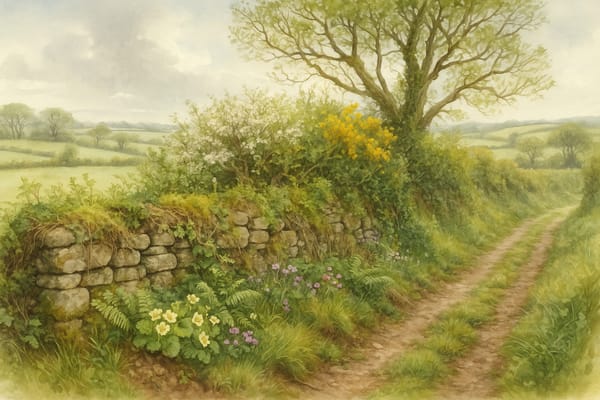Across Cornwall's wind-bitten fields and rolling pastures, one feature remains ever-present and quietly powerful: the hedgebank. These ancient boundaries, shaped by hand and time, crisscross the landscape with stone and soil, forming lines that have defined land, sheltered life, and held memory for millennia. Far more than quaint dividers, Cornwall's hedgebanks are living structures—resilient repositories of soil, biodiversity, and rural heritage. This article explores their hidden richness, ecological role, and future importance.
Living Lines in the Landscape
Cornish hedgebanks are unique in construction: earth-filled banks faced with stone and often topped with tangled shrubs, flowers, and small trees. Many trace back to the Bronze Age, their forms preserved through centuries of farming and local tradition. Today, over 30,000 miles of these features still thread the county, shaping both place and possibility (though estimates range from 20,000–30,000 miles depending on classification, heritage source, and survey method).
Soil Refuges and Reservoirs
Beneath the hedge lies a slow world. Free from plough and hoof, hedgebank soils are rich in organic matter, shaded by vegetation, and threaded with mycorrhizal fungi and earthworm tunnels. These pockets act as micro-reservoirs of fertility. Where heavy rains wash nutrients from fields, hedgebanks filter runoff, retain moisture, and anchor precious topsoil.
Soil testing projects by Duchy College and the Farm Carbon Toolkit have found that organic matter levels beneath Cornish hedgebanks regularly exceed 7.5% (compared to 2.7-4.8% in cropped fields), with higher pH stability, respiration activity, and porosity. In short, they act as buffers, recycling organic material while supporting adjacent productivity.
Nutrient Cycling and Ecosystem Services
As runoff moves across a field, the hedgebank acts like a sponge. Nutrients, leaf litter, and residues are absorbed and decomposed by fungi, beetles, and microbial life—releasing nutrients slowly back into surrounding soils. Where modern agriculture can disrupt nutrient cycles, hedgebanks restore them.
Older hedges often encapsulate layers of ancient soils and minerals, sometimes containing long-buried seed banks or pollen from earlier land use. These fragments of ecological memory provide insight into how Cornwall’s landscape has changed over time.
Wildlife Corridors and Biodiversity Havens
Cornish hedgebanks are true corridors of life. In spring and summer, their flanks erupt with native wildflowers—primroses, violets, thrift, moneywort—offering forage and habitat for bees, butterflies, and hoverflies. Beneath, the tangled roots and undisturbed soil host mice, hedgehogs, lizards, and amphibians.
Birds such as yellowhammers and dunnocks nest in the brambles or gorse. Slow worms bask in sun-warmed stone crevices. For many species, especially pollinators, the hedgebank is a lifeline in a fragmented agricultural landscape.
Historical and Cultural Significance
Hedgebanks do more than shape fields—they preserve stories. Many mark Bronze Age or Iron Age field systems. Their construction evolved with Cornwall’s geology: granite and serpentine in the west, slate and killas in the east.
Traditionally, these boundaries protected crops, marked ownership, and served as sources of forage, fuel, and material. Skills such as hedge-laying, coppicing, and stone-facing were passed down generationally and remain a living heritage, supported today by guilds, trusts, and training programs.
Place names reflect their presence too. Cornish field names such as "Gweal," "Croft," and "Park" often signify ancient enclosures or long-managed plots, each bordered and shaped by hedgebanks.
Monitoring the Unseen: New Tools and Insights
Modern technology allows us to see the hidden life of hedgebanks like never before. Soil health kits reveal higher earthworm counts and microbial activity. Camera traps catch hedgehogs and stoats using hedge bases. Acoustic sensors detect bats skimming hedgerow tops. eDNA soil testing uncovers amphibian traces and insect DNA in the soil profile.
Projects like the Penwith Landscape Partnership and Bude Valley Corridor Restoration have combined traditional stone rebuilding with drone mapping and citizen science. Wildlife sightings, soil samples, and plant records from these projects are building a new body of knowledge—proving the enduring value of these features for ecological resilience.
Agroecology and Stewardship
Cornwall’s hedgebanks now play a renewed role in future farming. Within Environmental Land Management schemes (ELMS and SFI), their restoration and protection is incentivised as a nature-based solution: reducing flood risk, storing carbon, supporting beneficial insects, and stabilising sloping land.
Gap-plugging with native shrubs, rotational cutting, and sensitive grazing all help hedgebanks retain their dynamic ecological value. When restored and connected, they form arteries of biodiversity that link farms, gardens, commons, and coastal habitats.
Old Boundaries, New Beginnings
To walk beside a Cornish hedgebank is to walk with history, with soil, and with life. These are not static relics, but active, living systems—enriching the land, stitching habitats together, and passing the wisdom of the past into the future.
As climate change pressures mount and farming seeks regeneration, these boundaries offer more than demarcation. They offer direction. With care, knowledge, and shared effort, Cornwall’s hedgebanks can continue to nourish the soil, the wild, and the stories rooted within them.








